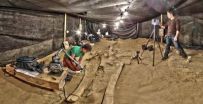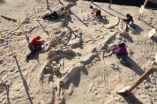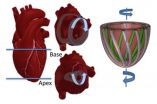(Press-News.org) Mass strandings of whales have puzzled people since Aristotle. Modern-day strandings can be investigated and their causes, often human-related, identified. Events that happened millions of years ago, however, are far harder to analyze—frequently leaving their cause a mystery. A team of Smithsonian and Chilean scientists examined a large fossil site of ancient marine mammal skeletons in the Atacama Desert of Northern Chile—the first definitive example of repeated mass strandings of marine mammals in the fossil record. The site reflected four distinct strandings over time, indicating a repeated and similar cause: toxic algae. The team's findings will be published Feb. 26 in the Proceedings of the Royal Society B.
The site was first discovered during an expansion project of the Pan-American Highway in 2010. The following year, paleontologists from the Smithsonian and Chile examined the fossils, dating 6-9 million years ago, and recorded what remained before the site was paved over.
The team documented the remains of 10 kinds of marine vertebrates from the site, named Cerro Ballena—Spanish for "whale hill." In addition to the skeletons of the more than 40 large baleen whales that dominated the site, the team documented the remains of a species of sperm whale and a walrus-like whale, both of which are now extinct. They also found skeletons of billfishes, seals and aquatic sloths.
What intrigued the team most, however, was how the skeletons were arranged. The skeletons were preserved in four separate levels, pointing to a repeated and similar underlying cause. The skeletons' orientation and condition indicated that the animals died at sea, prior to burial on a tidal flat.
Effects of Toxic Algae
Today, toxins from harmful algal blooms, such as red tides, are one of the prevalent causes for repeated mass strandings that include a wide variety of large marine animals.
"There are a few compelling modern examples that provide excellent analogs for the patterns we observed at Cerro Ballena—in particular, one case from the late 1980s when more than a dozen humpback whales washed ashore near Cape Cod, with no signs of trauma, but sickened by mackerel loaded with toxins from red tides," said Nicholas Pyenson, paleontologist at the Smithsonian's National Museum of Natural History and lead author of the research. "Harmful algal blooms in the modern world can strike a variety of marine mammals and large predatory fish. The key for us was its repetitive nature at Cerro Ballena: no other plausible explanation in the modern world would be recurring, except for toxic algae, which can recur if the conditions are right."
Harmful algal blooms are common along the coasts of continents; they are enhanced by vital nutrients, such as iron, released during erosion and carried by rivers flowing into the ocean. Because the Andes of South America are iron-rich, the runoff that has occurred along the west coast of South America for more than 20 million years has long provided the ideal conditions for harmful algal blooms to form.
From their research, the scientists conclude that toxins generated by harmful algal blooms most likely poisoned many ocean-going vertebrates near Cerro Ballena in the late Miocene (5-11 million years ago) through ingestion of contaminated prey or inhalation, causing relatively rapid death at sea. Their carcasses then floated toward the coast, where they were washed into a tidal flat by waves. Once stranded on the tidal flat, the dead or dying animals were protected from marine scavengers, and there were no large-land scavengers in South America at this time. Eventually, the carcasses were buried by sand. Because there are four layers at Cerro Ballena, this pathway from sea to land occurred four different times during a period of 10,000 to 16,000 years in the same area.
"Cerro Ballena is the densest site for individual fossil whales and other extinct marine mammals in entire world, putting it on par with the La Brea Tar Pits or Dinosaur National Monument in the U.S.," Pyenson said. "The site preserves marine predators that are familiar to modern eyes, like large whales and seals. However, it also preserves extinct and bizarre marine mammals, including walrus-like whales and aquatic sloths. In this way, the site is an amazing and rare snapshot of ancient marine ecosystems along the coast of South America."
3-D Technology at Cerro Ballena
Because the site was soon to be covered by the Pan-American Highway, time was very limited for the researchers. A major solution came in the form of 3-D technology. Pyenson brought a team of Smithsonian 3-D imaging experts to Chile, who spent a week scanning the entire dig site.
Although all the fossils found from 2010 to 2013 have been moved to museums in the Chilean cities of Caldera and Santiago, the Smithsonian has archived the digital data, including the 3-D scans, from the site at cerroballena.si.edu. There, anyone can download or interact with 3-D models of the fossil whale skeletons, scan Google Earth maps of the excavation quarries, look at a vast collection of high-resolution field photos and videos or take 360-degree tours of the site.
The enormous wealth of fossils that the team examined represents only a fraction of the potential at Cerro Ballena, which remains unexcavated. The scientists conservatively estimate that the entire area preserves several hundred fossil marine mammal skeletons, awaiting discovery. Pyenson's colleagues at the Universidad de Chile in Santiago are actively working to create a research station near the fossils of Cerro Ballena so that those that have been collected and those still covered by sediments can be protected for posterity.
INFORMATION: END
Smithsonian scientists solve 'sudden death at sea' mystery
Clues unearthed in an ancient whale graveyard
2014-02-26
ELSE PRESS RELEASES FROM THIS DATE:
Brain cell activity regulates Alzheimer's protein
2014-02-26
Increased brain cell activity boosts brain fluid levels of a protein linked to Alzheimer's disease, according to new research from scientists at Washington University School of Medicine in St. Louis.
Tau protein is the main component of neurofibrillary tangles, one of the hallmarks of Alzheimer's disease. It has been linked to other neurodegenerative disorders, including frontotemporal dementia, supranuclear palsy and corticobasal degeneration.
"Healthy brain cells normally release tau into the cerebrospinal fluid and the interstitial fluid that surrounds them, but ...
SMA unveils how small cosmic seeds grow into big stars
2014-02-26
New images from the Smithsonian's Submillimeter Array (SMA) telescope provide the most detailed view yet of stellar nurseries within the Snake nebula. These images offer new insights into how cosmic seeds can grow into massive stars.
Stretching across almost 100 light-years of space, the Snake nebula is located about 11,700 light-years from Earth in the direction of the constellation Ophiuchus. In images from NASA's Spitzer Space Telescope it appears as a sinuous, dark tendril against the starry background. It was targeted because it shows the potential to form many massive ...
Follow-up care for older breast cancer survivors needs to be all-encompassing
2014-02-26
Older women who have overcome breast cancer are likely to struggle with heart disease, osteoporosis and hypertension further on in their lives. Whether these conditions occur or not is influenced by the treatment that patients received to fight cancer, their overall weight and their age. Breast cancer survivors therefore should watch their weight and get regular exercise so that they can enjoy a high quality of life. These findings, by lead author Nadia Obi of the University Medical Center Hamburg-Eppendorf, who collaborated with the group of Prof. Chang-Claude from the ...
New research indicates causal link between vitamin D, serotonin synthesis and autism
2014-02-26
February 26, 2014 - Oakland, CA – A new study by Rhonda Patrick, PhD and Bruce Ames, PhD of Children's Hospital Oakland Research Institute (CHORI) demonstrates the impact that Vitamin D may have on social behavior associated with Autism Spectrum Disorder (ASD). Dr. Patrick and Dr. Ames show that serotonin, oxytocin, and vasopressin, three brain hormones that affect social behavior, are all activated by vitamin D hormone. Autism, which is characterized by abnormal social behavior, has previously been linked to low levels of serotonin in the brain and to low vitamin D levels, ...
Beaumont study: Gamma Knife helps patients with painful facial nerve disorder
2014-02-26
Research by Beaumont Health System radiation oncologists and neurosurgeons found that symptoms of trigeminal neuralgia, or TN, a nerve disorder causing severe facial pain, were reduced in those treated with Gamma Knife stereotactic radiosurgery. The results were published in the February issue of the journal Clinical Neurology and Neurosurgery.
TN is a disorder of the trigeminal nerve, which is responsible for feeling in the face. In most cases, the facial pain is caused by a blood vessel pressing on the nerve. It is believed that TN is caused by deterioration of the ...
Reproductive coercion, intimate partner violence prevalent
2014-02-26
Enough women experience reproductive coercion – male behavior to control contraception and pregnancy outcomes – that a research team now recommends health care providers address the subjects with their patients and tailor family planning discussions and recommendations accordingly.
Researchers from Women & Infants Hospital of Rhode Island were part of a team that published "Reproductive coercion and co-occurring intimate partner violence in obstetrics and gynecology patients" in a recent issue of the American Journal of Obstetrics and Gynecology.
"Reproductive coercion, ...
Artificial muscles that do the twist
2014-02-26
In the heart, as in the movies, 3D action beats the 2D experience hands down.
In 3D, healthy hearts do their own version of the twist. Rather than a simple pumping action, they circulate blood as if they were wringing a towel. The bottom of the heart twists as it contracts in a counterclockwise direction while the top twists clockwise. Scientists call this the left ventricular twist—and it can be used as an indicator of heart health.
The heart is not alone. The human body is replete with examples of soft muscular systems that bend, twist, extend, and flex in complex ...
Superabsorbing design may lower manufacturing cost of thin film solar cells
2014-02-26
Researchers from North Carolina State University have developed a "superabsorbing" design that may significantly improve the light absorption efficiency of thin film solar cells and drive down manufacturing costs.
The superabsorbing design could decrease the thickness of the semiconductor materials used in thin film solar cells by more than one order of magnitude without compromising the capability of solar light absorption.
"State-of-the-art thin film solar cells require an amorphous silicon layer that is about 100 nanometers (nm) thick to capture the majority of the ...
A cavity that you want
2014-02-26
BUFFALO, N.Y. – Associated with unhappy visits to the dentist, "cavity" means something else in the branch of physics known as optics.
Put simply, an optical cavity is an arrangement of mirrors that allows beams of light to circulate in closed paths. These cavities help us build things like lasers and optical fibers used for communications.
Now, an international research team pushed the concept further by developing an optical "nanocavity" that boosts the amount of light that ultrathin semiconductors absorb. The advancement could lead to, among other things, more powerful ...
Thirty-nine new species of endemic cockroach discovered in the southwestern US and Mexico
2014-02-26
A genus of cockroach in the poorly studied family Corydiidae has been revised for the first time since 1920. The revision has resulted in the discovery and description of 39 new species of Arenivaga, a genus which previously held nine species. The Corydiidae family of roaches is found worldwide and its constituents are frequently found in harsh, dry habitats not usually associated with cockroaches. They are also often subterranean in their habits making their presence easily overlooked.
The study was completed over a four-year period by Heidi Hopkins, who is a cockroach ...
LAST 30 PRESS RELEASES:
School meals could unlock major gains for human and planetary health
Menopause hormone therapy does not appear to impact dementia risk
Signature patterns of brain activity may help predict recovery from traumatic brain injury
Dresden study uncovers new key mechanism in cancer cells
New species are now being discovered faster than ever before, study suggests
Cannabis-based products show limited short-term benefit for chronic pain, with increased risk of adverse effects
Cannabis products with more THC slightly reduce pain but cause more side effects
Clearing the brain of aging cells could aid epilepsy and reduce seizures
Brain injuries linked with potential risk of suicide, new study finds
New technique lights up where drugs go in the body, cell by cell
New study finds movement of fishing fleets can reveal shifts in marine ecosystems
Embargoed: New evidence points to potential treatment for vascular dementia
Study uncovers disrupted brain balance in alcohol dependence
Working in groups can help Republicans and Democrats agree on controversial content moderation online
Structural findings reveal how distinct GPCR ligands create different levels of activation
Anything-goes “anyons” may be at the root of surprising quantum experiments
UC review: Maximizing workplace opportunity for veterans
From generation to complex control: Metasurfaces make perfect vortex beams "within reach"
Thin-film lithium niobate-based detector: recent advances and perspectives
Exploring why some people may tend to persistently make bad choices
How cells balance their protein levels
Nirsevimab vs RSVpreF vaccine for RSV–related hospitalization in newborns
Effectiveness and impact of maternal RSV immunization and nirsevimab on medically attended RSV in US children
AI gives scientists a boost, but at the cost of too many mediocre papers
Next-generation vision model maps tree growth at sub-meter precision
Genes aren’t destiny for inherited blindness, study shows
MIT study: High-fat diets make liver cells more likely to become cancerous
Exposure to multiple fine particulate matter components and incident depression in the US Medicare population
Risk of burdensome health care spending over time in the US
Nirsevimab against hospitalizations and emergency department visits for lower respiratory tract infection in infants
[Press-News.org] Smithsonian scientists solve 'sudden death at sea' mysteryClues unearthed in an ancient whale graveyard








